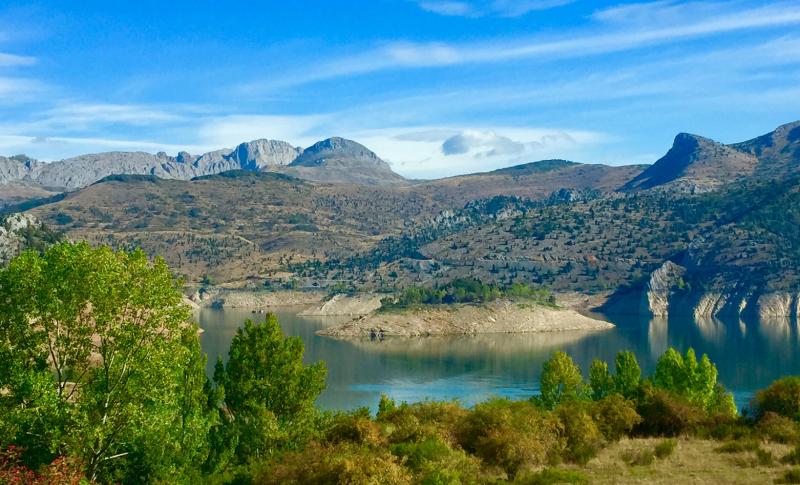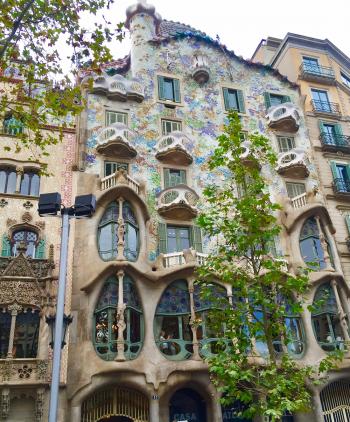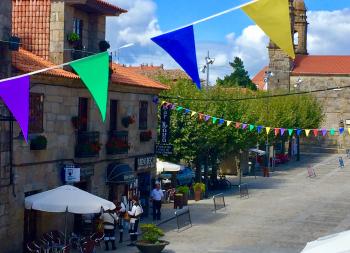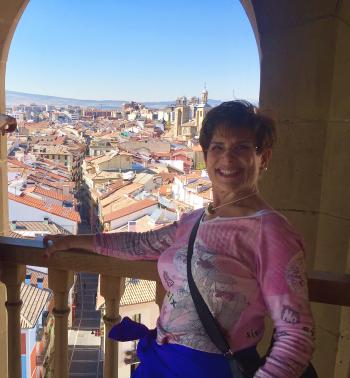A serendipitous self-drive journey through Spain
This article appears on page 34 of the August 2017 issue.
Following a wine-focused cruise through Italy, Croatia, Montenegro, Greece, France and Spain, which ended in Barcelona in September 2016, my friend JoRene and I decided to explore the Basque Country of Spain (and France) by car.
My preferred method of travel is to be independent and meander. The experiences that can be had are so much more serendipitous when you’re not on a schedule or traveling with a group. There are pluses and minuses with both, but this mode of travel makes my heart sing.
My 80-year-old friend JoRene was up for the challenge, so we decided to extend our trip by 14 days. The only hitch was that neither of us has a good sense of direction. In fact, on our travels, people have been known to watch which way we exit a hotel room to find the elevator and then they turn in the opposite direction. This was a scary yet gutsy decision. (It helped that I am bilingual in Spanish.)
Beginning in Barcelona
My biggest thrill was that Araceli Valdes, a teacher from Murcia in southeastern Spain, flew up to spend three days with us in Barcelona. She taught with me for a year at Silverado Middle School in California (she was on loan with five other teachers from Spain that year), and we formed a bond and friendship that has endured for 13 years.
In my previous visits to Spain, I had never visited Barcelona.
We walked everywhere that first night. Strolling down La Rambla (I was told that it used to be an elegant, wide boulevard, but today it’s a tacky tourist mecca), luckily we found ourselves in El Born, a charming, café-loaded neighborhood that was “happening.” It was everything I dreamed late-night Barcelona would be.
In Barcelona for three days, we elected to explore the city on foot with Runner Bean Tours (phone +636 108 776; runnerbeantours.com), a great company. The tours we chose were “free”; participants just give the guide whatever amount they feel is fair as a “donation” at the end.
We walked for miles, exploring Antoni Gaudí’s Casa Batlló and Casa Milà (aka La Pedrera), both indescribable works of architecture and beauty. We meandered through the Jewish Quarter, with its narrow, winding streets, and Barri Gòtic (Gothic Quarter), home to the amazing Museu Picasso.
A celebration
We were so fortunate to be there the week of La Mercè, the biggest festival of the year in Barcelona, honoring the city’s patron saint, the Virgin of Mercy. At every corner, there was something — marches, human pyramids (castells), parades of giant figures (gigantes) and dignitaries speaking to massive crowds. It was an exciting time to be part of the fabric of the city.
That night we booked a walking excursion to discover Barcelona’s tapas, wines, neighborhoods and back alleys with hidden cafés, led by an eclectic, in-the-know, “aging hippy” guide. He was fabulous!
The never-ending food flowed, and our group of eight (mostly young millennials) was fun. As we wended our way through the lively darkened streets (Spain wakes at 9 p.m.), our guide managed to find a light show happening at the exact right moment (in celebration of La Mercè). It was a night to remember.
Day 3 began with JoRene and me getting lost three times trying to find Gaudí’s Sagrada Família, a huge Roman Catholic church begun in 1882 and promised to be completed by 2026 (not likely). Guadí’s creation is a masterpiece nonpareil.
Serendiptous happenings
Returning to my favorite Barcelona neighborhood, El Born, our young, hip female taxi driver made some calls and directed us to a “hidden” restaurant, La Paradeta Born (c/Comercial 7; laparadeta.com). You stand in line, pick out your fresh seafood and tell them how you want it cooked… all at the counter. We shared our feast (€17.50, or $20, with wine) with others nearby, and they reciprocated. It was informal, convivial and unique — a real “find.”
Toward the end of our touring day, we were tired, with sore feet, but I had a sense that something was going on, so I followed my instincts. I saw lots of people walking “with a purpose,” and we followed, ending up in a huge square with a crowd of thousands listening to políticos giving speeches.
JoRene and I were a little uneasy with the presence of a passionately boisterous group of protesters angry at mass tourism, focusing on local apartment rentals without permits (i.e., illegal Airbnb properties). Their banners read, “Mi casa no es tu casa” (My house is not your house). The people of the Catalonia region were angry at the tourism they see as ruining their province.
Fearful that the crowd could erupt, we wound our way through the hordes and soon found ourselves in the middle of a riotous parade of giants, an important feature of the Catalan culture. Each city or parish has its own set of papier-mâché giants, which are always part of every festival and usually represent historical or popular characters. Figures standing 15 feet tall were twirling, teasing, dancing and “singing” as colorfully happy crowds marched down the narrow streets.
Topping off the night at a locally recommended tapas restaurant, we gorged on fried padrón peppers soaked in olive oil.
Hitting the road
Now came the real test. It took these two senior women over an hour to figure out the gizmos of our rental car before jumping into the fray of Barcelona’s roundabouts on our way out of the city. (The rental agency finally locked the door to prevent me from running back in one more time to ask a question. They just smiled and waved.)
Even with two GPS systems, we got lost leaving the city.
I decided that I wanted our journey to follow the yellow arrows that we encountered along the way. These arrows are situated along the 800-kilometer path known as the French Way, and they direct pilgrims from the path’s start in St. Jean-Pied-du-Pont to the shrine of the apostle St. James in the Cathedral of Santiago de Compostela in Galicia.
Our goal was to drive west from Barcelona all the way to Santiago, on the opposite coast. Our first stop, after a 7-hour drive, was Logroño, the capital of the wine province of La Rioja.
We dropped off our luggage at our hotel and started a very long walk toward the center of town.
The angel of travel was with us. All of a sudden, we found ourselves in the middle of an annual, multiday, end-of-harvest celebration. We jumped right in.
As we walked all over central Logroño that night, I felt that we had stepped back in time. Lovely older folks, dressed as if they were frozen in the ’60s, sat at sidewalk cafés with their extended families.
Street snacks
As the evening progressed, we found the town’s horseshoe of narrow streets known for their pintxos (small snacks popular in the Basque Country). There were in excess of 50 pintxos bars, squashed side by side, and they were jam-packed. Everyone was squeezing by each other sideways, leaning in and out of the bars, visiting, eating, drinking and trying to push their way through the crowds to the next bar.
Typical in northern Spain, the pintxo is a single small serving designed to be a snack for one person, whereas tapas, found throughout Spain, are meant to be shared. Therein lies the difference.
All the dishes were displayed in glass cases either in front of the bar on the street or inside the establishment. At 4 o’clock in the afternoon, the dishes would go out and the food would be continually replenished throughout the night.
When you pointed to your pintxo of choice, they threw it in the microwave, if necessary, then you quickly ate it and moved aside to make room for the next customer.
Wine cost less than $1 a glass, and pintxos were about $2 apiece.
Time for some wine
Using Logroño as our home base, we ventured out into the countryside to explore a couple of the famous La Rioja bodegas (wineries). Our first stop was Ontañon, reminiscent of wineries in California’s Napa and Sonoma valleys. The sprawling, beautifully groomed vines and the hundreds of olive trees, heavy with fruit, were picture-perfect.
Next was Vivanco, in the tiny village of Briones, a high-end bodega with an amazing wine museum documenting the history of wine in La Rioja. Our experience there was comprehensive and enlightening and was topped off with delicious wines.
On our last day in the region, we enjoyed “thieving” wine at our own discretion from the barrels of the very large Ramón Bilbao Winery.
Pamplona
As we drove west across Spain, from the province of La Rioja to the Navarra (Navarre) province in the Basque Country, we were struck by the starkness of the high desert landscape. It was a surprise.
We ventured on to Pamplona, the capital of Navarra. Pamplona (aka Iruña) is a compact city, its narrow, cobbled streets seemingly squashed together to fit within its commanding walls.
We walked for miles, exploring well-kept ruins in the city center, surrounded by pintxos bars with hanging hams everywhere. People were relaxed, leisurely enjoying themselves at every turn.
In contrast, the streets were empty during siesta, which for shops and businesses is from approximately 2 to 5 p.m. (Bars and restaurants close from about 4 until 8 or 9.) Spaniards take their siestas seriously!
We had the city to ourselves during those hours. We did not want to waste one moment, so we would explore and stop for wine when we found someplace open.
Pamplona is famous for its connection to Hemingway and for the San Fermín Festival, featuring the annual running of the bulls, where angry/ scared bulls wildly chase thousands of red-kerchiefed, white-shirted, black-bereted men trying to outrun them.
The streets are so narrow, and the doors lining the route are all shut during the event, so there is nowhere to step up or hide. It’s wild! Runners get badly gored every year.
Out and about
Using Pamplona as our next home base, we ventured out to San Sebastián (Donostia), home to beautiful circular beaches and fabulous food.
Throughout the Basque region in Spain, the pintxos bars were welcoming and economical. The colors, textures and compelling aromas of the small plates displayed were seductive, and those in San Sebastián were no exception.
The next day, we drove two hours from Pamplona in another direction and spent the blustery, rainy day exploring the architecturally amazing Guggenheim in Bilbao. Designed by Canadian-American architect Frank Gehry, it is a museum of modern and contemporary art. For such an immense museum, however, I felt that the collections were rather limited, though there were several exhibits that were wonderful.
As we were so close to France, we thought, ‘Why not go to Biarritz?’
We had become accustomed to the friendliness and helpfulness of the Spanish people we encountered when we needed assistance or direction, so when we got to a tollgate at the border crossing and couldn’t figure out what to do with the nonmanned money taker, we gestured for help from a soldier standing there. He shook his head and said, “No.”
We were stuck. We couldn’t read the sign in French to know how much money to pay or where to insert it.
The drivers behind us were becoming increasingly frustrated. Finally, a man ran up, threw some coins into our machine and gestured for us to move.
Welcome to the Basque Country of France!
By the sea
As we drove toward Biarritz, a luxurious seaside community on the Bay of Biscay, we were mesmerized by the uniform design of the houses, featuring red, black and green shutters, often with patterns visible in the cement left exposed around the windows.
We passed through a bucolic, lushly green landscape, with rolling hills and the Pyrénées rising in the background. Fat, content sheep, horses and cows with tinkling bells were everywhere. I felt like I was in a children’s picture book!
By the end of the day, we had also explored St-Jean-de-Luz, Sare, La Rhune and other small villages. Meandering without plans is a great way to travel, and this day, spent lost in the mountains, was one of a kind.
Interesting explorations
Early the next morning, back in Pamplona, I set out to climb to the very top of the city’s Roman Catholic cathedral. I joined a small group of intrepid travelers winding their way up the hundreds of steep, curving stairs all the way to the bell tower.
It was scary on the way up and trickier on the way down. We were offered access through secret doors to see the inner construction of the cathedral.
On this trip, one of the things JoRene and I fell in love with were sandwiches made from thinly sliced Serrano ham and Manchego cheese on fresh, crispy rolls slathered with mayonnaise — a Spanish mainstay. We started making them in our hotel rooms at night and munched them during our daily drives. We even carried some home in our suitcases and ate them back home in Napa!
As we continued our drive along the pilgrims’ trail on the way to Santiago de Compostela, we spent the night in Burgos, in the autonomous community of Castile and León. We dropped our suitcases off and ran out to find some excitement.
The streets were empty at first, as everyone was on siesta, but at 5 o’clock everything came alive.
We ended up with a roving band of musicians from Murcia, in southeastern Spain. These tuna bands are all over Spain. They raise money for college by playing music as they travel, and they’re given food and drink as they provide entertainment in restaurants.
One lesson learned during our stay in Burgos — in ancient city-center hotels, though they’ve been modernized, the infrastructure might not be commensurate with modern-day standards. As we entered the underground parking garage of our Burgos hotel, no one warned us that the curved lanes leading further underground would be so narrow.
We arrived at the first hairpin turn with our small BMW rental, and we got stuck. We couldn’t go forward or backward without crunching the wall to execute the turn, and we ended up scratching the car. It was a nightmare.
When we left the next morning, I begged the management to drive the car out. Thankfully, someone did.
Continuing to Santiago
Finally, we were on the last leg of our journey. We left the main roads, attempting to follow the final leg of the rural route of the pilgrims, El Camino de Santiago. Thousands of people walk, ride horseback or bike to Santiago, following the yellow arrows, many seeking spiritual growth and some making lifelong friends along the way.
To officially complete the journey, one must walk their chosen route all the way to Santiago, where the exhausted yet satisfied pilgrims gather in the cathedral square, drop to the stone pavement with a look of serene pride on their faces, lay their backpacks and walking sticks down and share their experiences with each other.
After checking into our hotel in Santiago, we walked into the center of the Old City. Immediately, we got lost.
I asked a young college student we encountered if he could direct us to O Gato Negro (Black Cat Bar), which was reputed to have the best seafood pintxos and padrón peppers in Santiago. He insisted on giving us a tour of the old center of Santiago, leading us through the hordes of late-night revelers, before he delivered us to the door of the destination we sought. We would never have found this place without his unbelievable assistance.
Not knowing what to do or where to stand, we made friends with a Spanish couple, who helped us order and ended up spending the rest of the evening with us. Not a word of English was spoken.
On the way back to our hotel, after having tasted some local grappas, cheeses and wines, we found ourselves lost yet again. A couple of hikers, giddy with pride that they had just completed their pilgrimage, insisted on accompanying us all the way back to our hotel.
Everyone we met that night was warm, welcoming and helpful. Spain is incredible!
Finding friends
For the next five days, we used Santiago de Compostela as our home base. Every time we talked to a stranger, their suggestions sent us in a new direction, with wonderful consequences.
We drove into the province of Gallego and the town of Cambados, where a young couple befriended us, suggesting that we find a specific neighborhood with great cafés.
We grazed on seafood — and loved the custom of being served a plate of complimentary pintxos when ordering a glass of wine. The whole afternoon was a culinary hoot!
Soon it was Sunday, and nothing was open. We didn’t want to lose the day, so we got in the car and, deciding to leave the main road, ended up on a precarious, winding mountainous path with not a soul in sight for hours. We had no idea where we were heading.
Finally, we saw a small bus of Portuguese tourists (at a phenomenal lookout point), and I jumped out of the car and ran up to them. One person in the group spoke Spanish and comforted me with news that we should keep on going.
Eventually, we found the town of Chantada, way up in the mountains. Farther on, we found the tiny hamlet of Doade and a winery, Regina Viarum, that was open and in full swing with harvest. Everyone, including the owner, was bringing in huge, ripened bunches of grapes, crushing them and just having fun. They invited us to join in the merriment.
Our amazing adventure was complete. What made the trip so much more spectacular were the connections with the people we met as we traveled. Personal experiences like these are what make each trip memorable.





